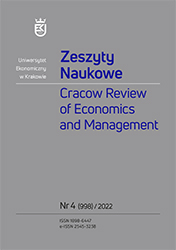Differentiation of Beta Coefficients during COVID-19 Pandemic – the Example of Stocks of the Largest Companies Listed on the Warsaw Stock Exchange
Differentiation of Beta Coefficients during COVID-19 Pandemic – the Example of Stocks of the Largest Companies Listed on the Warsaw Stock Exchange
Author(s): Bartłomiej LisickiSubject(s): Health and medicine and law, Financial Markets
Published by: Wydawnictwo Uniwersytetu Ekonomicznego w Krakowie
Keywords: interval effect; beta coefficient; COVID-19; Warsaw Stock Exchange; shares;
Summary/Abstract: Objective: The article seeks to determine whether the occurrence of the interval effect of beta coefficients (β) occurred among chosen shares in Warsaw Stock Exchange Index (WIG) during the COVID-19 pandemic. Research Design & Methods: The article seeks to determine whether in 2020 and 2021 (when the COVID-19 pandemic was spreading globally) it was possible to observe other levels of the β for chosen companies traded on the WIG. It examines a different approach to estimating returns of the companies’ shares (daily, weekly, biweekly and monthly). β coefficients are calculated with the ordinary least squares method (OLS) on the research sample of issuers traded on the three main Warsaw Stock Exchange (WSE) indices: WIG20, mWIG40 and sWIG80. Findings: The values of the β coefficients, calculated for different time horizons of returns (daily, weekly, biweekly and monthly) showed significant differences. These differences were statistically significant for pairs of β calculated for daily and weekly/biweekly/monthly returns, as well as for weekly and biweekly ones. Moreover, it was noted that the interval effect is invariably stronger for companies with lower capitalisation. The β increased for companies with the highest level of capitalisation as the time interval of returns was extended, which the literature has to this point reported only for Asian markets in crisis years. Implications / Recommendations: The results indicate that the COVID-19 pandemic did not influence the occurrence of the interval effect observed on the Polish capital market earlier, and only slightly changed some of its detailed characteristics. However, the differentiation of the β (depending on the time horizon of returns used to calculate it) does not make it an effective measure of the risk of investing in securities. Contribution: Conducting research on the occurrence of the interval effect on the WSE during the COVID-19 pandemic will contribute to the knowledge base of capital market participants, particularly on the use of β to measure systematic risk in times of instability on capital markets. Understanding this issue in the context of investing funds on the WSE will be useful for those seeking to adjust investment portfolios to the changing realities of the Polish capital market.
Journal: Zeszyty Naukowe Uniwersytetu Ekonomicznego w Krakowie
- Issue Year: 998/2022
- Issue No: 4
- Page Range: 11-28
- Page Count: 18
- Language: English

